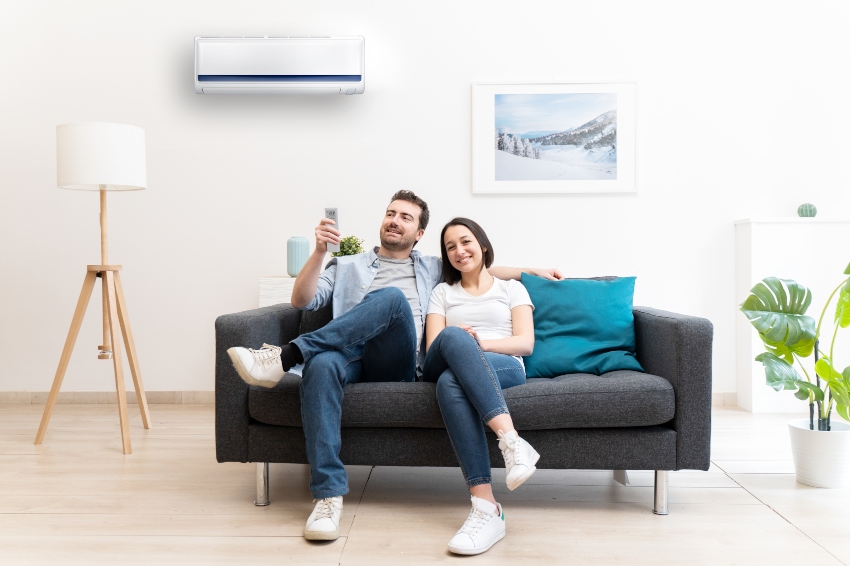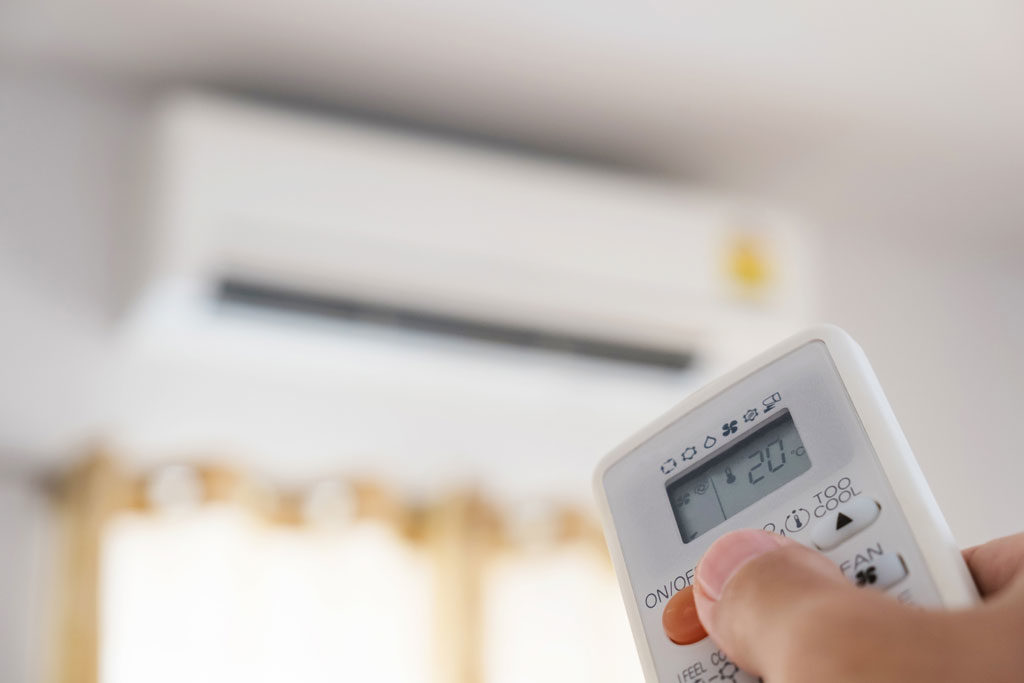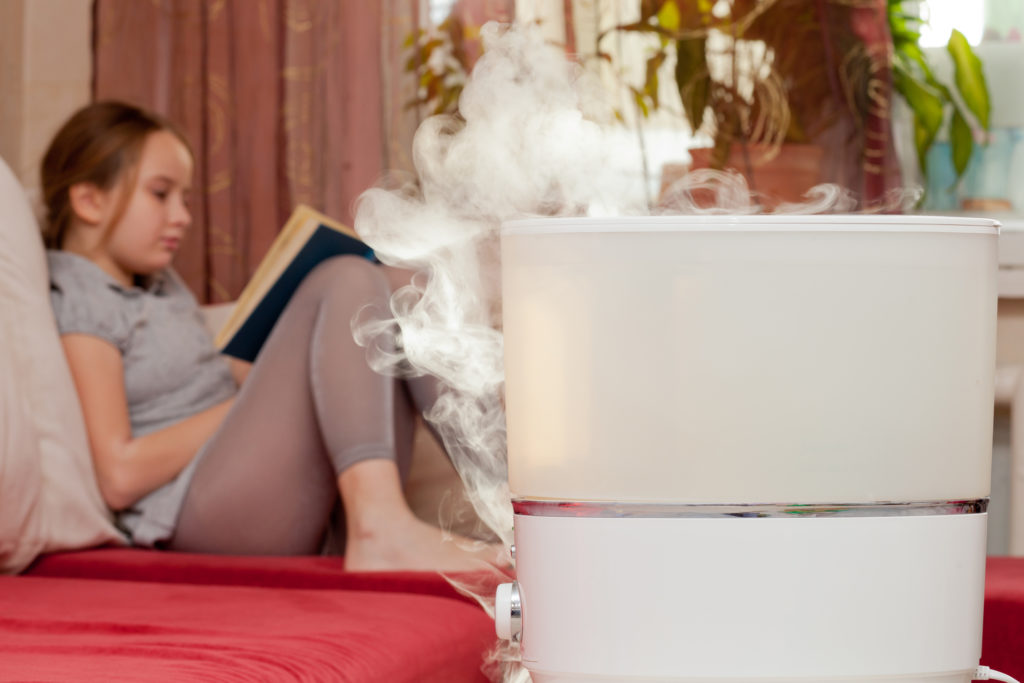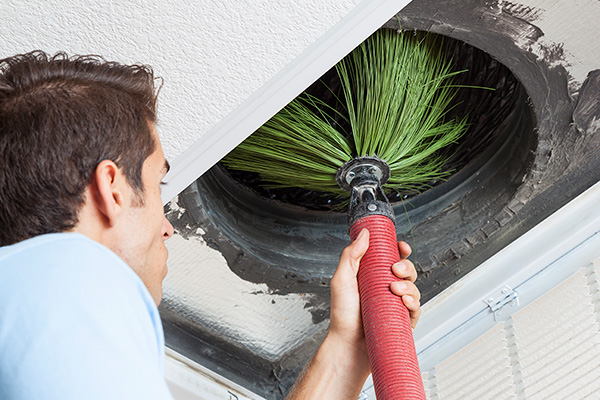Indoor Air Quality Tips to Help You Breathe Easy This Summer
Posted on by WestAIR Heating & Cooling

In the hottest summer months, there’s nothing quite like drinking a glass of iced tea and sitting in an air-conditioned room. But that seeming escape can actually be detrimental for your health if you have poor indoor air quality. From headaches, fatigue, and trouble concentrating to irritation of the eyes, nose, and throat, indoor air contaminants have been linked to diseases like asthma. How can you improve the air quality in your home? There are a number of available solutions. We’ve pulled a few of them together here to help you decide which one is right for you. Read on as we discuss indoor air quality tips to help you breathe easy this summer.
Air Exchangers for Fresh, Filtered Outdoor Air
Circulation is critical for good indoor air quality. Stale indoor air can become thick with contaminants and excess humidity, which can lead to mold growth. An air exchanger like the Venmar® Ventilation System, provides your home with a continuous flow of filtered outdoor air, reducing humidity and expelling pollutants from the home.
Take Air Quality a Step Further with an Air Cleaner
With an air cleaner, you can upgrade your existing heating and cooling system to help you improve the air you breathe. These systems capture airborne dust, pollen, and other particles far better than your standard furnace filter, helping eliminate pollutants in the air.
The Power of Ultraviolet Light
UV light technology can go beyond removing airborne particles to eliminating volatile organic compounds (VOCs) and reducing microorganisms. The best part? UV air purification systems like the BreatheCLEAN UV air purifier can be easily installed into existing ductwork with no major changes to your HVAC system.
If you’re looking to breathe easier, the experienced indoor air quality professionals at WestAIR are here to help. See what our customers have to say, and then contact us to schedule a service today!
This entry was posted in AC,Air Conditioning,Health Tips,Indoor Air Quality,Tips and tagged Air cleaner, Air exchanger, Importance of Indoor Air Quality, Indoor air quality, Indoor air quality solutions, Indoor Air Quality Tips, Summer, Summer Cooling, Summer HVAC, Summer HVAC Tips, Ultraviolet Light Air Purification, UV Light Air Purification, UV lights, WestAIR Heating & Cooling
7 Tips for Winter Indoor Air Quality Maintenance
Posted on by WestAIR Heating & Cooling

With the recent snowfall and chilly temps, there’s no denying that winter is almost here. Time to prepare! As heating season makes its way to Minnesota, we must remember to keep the air in our home clean as well as warm. Use this guide to winter indoor air quality maintenance to keep your family cozy, healthy, and happy throughout the season.
Poor Winter Indoor Air Quality: Causes and Effects
When cold weather hits, we seal our homes to prevent the warm air produced by our furnaces from escaping. While this helps increase comfort and energy efficiency, it also traps dust, pollen, and other airborne contaminants inside the home that then decrease indoor air quality. Common signs of poor winter indoor air quality include:
- Dry, itchy, or watery eyes
- Cold or flu symptoms: coughing, sneezing, nausea
- Heightened symptoms of asthma and other respiratory illness
- Fatigue and trouble concentrating
- Irritation of the nose and throat, particularly dryness
- Headaches
Tips for Winter Indoor Air Quality Maintenance
Escaping the bitter cold of Minnesota winters means spending more time inside our home, making clean indoor air crucial to our comfort and health. Thankfully, homeowners can improve and maintain air quality with these helpful tips.
- Clean regularly – Don’t let dust, mold spores, and other pollutants build up around the home. Dust hard surfaces and vacuum (using a vacuum with a HEPA filter if possible) at least weekly. Use non-toxic cleaners free of volatile organic compounds (VOCs), which are a major contributor to unhealthy air.
- Maintain a clean filter – Air filters keep dust and other debris from entering and harming your HVAC system, but must be maintained in order to prevent these irritants from making their way back into the air. Remember to change air filters monthly or clean if resuable.
- Schedule annual service maintenance – Ensure your heating system runs at peak performance and provides clean, warm air with professional maintenance service from a WestAIR HVAC expert.
- Have your ductwork cleaned – Dirt, dust, pet hair and dander, and other irritants settle inside your air ducts over time. Schedule duct cleaning service before winter is in full swing, and plan to do so annually.
- Enhance ventilation with an air exchanger – Sealing the home in winter leads to recycled, stale air inside. To resolve this, air exchangers deliver a continuous flow of fresh, filtered outdoor air while simultaneously exhausting unhealthy indoor air.
- Control humidity with a whole house humidifier – Humidity plays a crucial role for indoor air quality. Dry winter air can cause nose, throat, and skin discomfort, as well as damage wood fixtures and furniture over time. Installing a whole house humidifier will help maintain proper humidity levels in your home.
- Consider additional clean air solutions – Air cleaners work with your current system to remove excess dust and other irritants that decrease indoor air quality. Ultraviolet (UV) light purification systems utilize UV rays to eliminate odors harmful airborne pathogens like viruses, bacteria, mold, and VOCs.
This year has presented us all with new and unique challenges. But no matter how unpredictable 2020 has been, we know we can always plan for harsh winter weather here in Minnesota. We’re already seeing the temps drop and snow fall, so don’t wait! Use these winter indoor air quality maintenance tips to enjoy clean, comfy air inside your home this heating season.
For all your heating and cooling needs, trust the HVAC experts at WestAIR. Contact us today to learn more.
This entry was posted in Duct Cleaning,Furnace,Health Tips,Heating,Humidifier,Humidity,HVAC Maintenance,Indoor Air Quality,Tips,Winter and tagged Air cleaner, Air exchanger, Duct cleaning, Duct cleaning service, Heating, Heating Tips, Humidfier, Humidity, Humidity Management, HVAC tips, Indoor air quality, Indoor air quality solutions, Professional duct cleaning, Residential HVAC, Ventilation, WestAIR Heating & Cooling, Winter, Winter HVAC, Winter HVAC Tips, Winter Indoor Air Quality, Winter Indoor Air Quality Maintenance, Winter Tips, Winterize
Tips for Controlling Spring Allergies at Home
Posted on by WestAIR Heating & Cooling

Seeing warmer weather and longer days is bittersweet for allergy sufferers. Spring may be in the air, but so are pesky allergens. As we spend more time in our homes during the COVID-19 pandemic, indoor air quality becomes more important than ever. Use these helpful tips for controlling spring allergies at home to stay healthy and comfortable.
Change Shoes and Clothing After Being Outdoors
Controlling allergies begins with limiting exposure to allergens. Limit your time outdoors whenever possible. If you do venture out, don’t wear the same clothing and shoes around your home. Dirt, dust, pollen, and other irritants can cling to you and your wardrobe. Avoid tracking them around by changing as soon as you return home.
Dust, Vacuum, and Mop Regularly
Dust and allergens will settle on the surfaces of your home. Try to clean them at least weekly, and more often if you are leaving windows and doors open.
Have Your Ductwork Cleaned
Air ducts transport fresh air between your home and HVAC system, and over time will collect dust, pollen, and other airborne particles that travel through them. Having them cleaned annually is vital to indoor air quality. Schedule a professional duct cleaning service to help ensure you’re ready for the season.
Maintain a Clean Air Filter
The air filter blocks airborne irritants from getting into your system. However, it becomes dirty and less effective over time. If left long enough, the filter can also become clogged and make your system work harder, causing higher bills and faster wear and tear. Change (or clean it if re-usable) your air filter monthly to keep the system running properly.
Install an Air Cleaner
The name says it all. An air cleaner uses a filter to trap up to 97 percent of airborne bacteria, mold, dander, and other pollen-sized irritants. It can also eliminate viruses, kill germs, and neutralize odors and fumes.
Invest in Ultraviolet (UV) Light Air Purification
Breaking through an organism’s cell wall to destroy its DNA, UV light rays prevent that organism from reproducing and causing illness. UV technology has been around for over 100 years, and many homeowners today utilize it as a highly effective way to kill harmful bacteria, mold, and viruses in the home.
These systems conveniently work in conjunction with your current HVAC system. WestAIR is an authorized dealer of BreatheCLEAN UV air purification systems. Contact us to learn more or to schedule your UV light system installation.
Consider an Air Exchanger
Letting fresh air into the home can be beneficial, but it brings allergens along with it. An air exchanger solves this by exhausting stale indoor air and excess humidity while also delivering a continuous flow of filtered outdoor air inside. Installing a programmable thermostat will help you maintain indoor comfort without constantly managing temperature. And again, remember to keep your filter clean!
Controlling spring allergies at home comes down to limiting exposure to allergens. It sounds simple, but don’t be fooled into thinking the home is a completely irritant-free safe space. While we may be spending less time outdoors than usual this spring, use these tips to maintain indoor air quality and keep allergy symptoms at bay.
WestAIR’s HVAC experts are here for all your heating and cooling needs. As we continue helping our customers prepare their homes for the spring and summer during this time, our team is taking extra precautions to protect the health and safety of themselves and everyone they service. We prioritize your comfort and satisfaction in all that we do. Contact us today to schedule service and learn more.
This entry was posted in AC,Air Conditioning,Cooling,Duct Cleaning,Health Tips,Indoor Air Quality,Spring,Tips and tagged Air cleaner, air conditioning, Air exchanger, Air filters, Family Health, Family Safety, Heating, Home Heating, Home Safety, Homeowner Education, Homeowner Tips, HVAC Safety, HVAC tips, Importance of Indoor Air Quality, Indoor air quality, Spring Allergies, Spring Cleaning, Spring Heating and Cooling, UV Light
Indoor Air Quality Solutions
Posted on by WestAIR Heating & Cooling

Ever looked at a ray of light streaming through your windows and noticed floating dust particles? The sunlight can reveal a lot about a room’s air quality. While it may be tempting to open up the windows and doors for a quick fix, we’re in the thick of ragweed season, so it probably won’t do you any favors. The EPA recommends upgrading your HVAC filter or using an air cleaner to reduce harmful airborne particles. Read our blog to learn why and discover some more indoor air quality solutions.
New filters
Your HVAC filter traps microorganisms, animal fur, hair, lint, dander, mold, pollen, dirt, and more so they don’t accumulate in your system or irritate your lungs. Check your filter once a month to see if it needs replacing. A clogged air filter can cause your HVAC equipment to overheat, short cycle, or even break down. At the very least, changing a dirty filter could lower your energy bills because your system won’t have to work twice as hard just to obtain adequate airflow.
Air cleaner
An air cleaner uses a filter to trap particles like bacteria, mold, ragweed, pet dander, and dust mites. It can even eliminate viruses, kill germs, neutralize fumes, and remove odors. Those with allergies, asthma, or sensitivity to chemicals can benefit from an air cleaner, which can remove up to 97 percent of pollen-sized particles.
Air exchanger
Every time you cook, shower, clean, and breathe, you release pollutants into the air. Airtight buildings are more energy efficient, but they need to somehow circulate air to maintain a healthy environment. Without adequate ventilation, old air will sit in enclosed spaces and accumulate dust, bacteria, mold, and other harmful particles.
An air exchanger provides refreshed, filtered air to reduce these allergens. Air exchangers use two fans, one to take stale air out, and the other to pull in fresh air, run it through a filter, and disperse it through the ductwork.
Dehumidifier
Humidity makes a room seem hotter than it is and increases the likelihood of mold and mildew growth. Drier air feels cooler. A dehumidifier can increase your comfort and allow you to raise the temperature a few degrees to save on cooling expenses. You can use a portable unit or install a whole house dehumidifier that works in conjunction with your HVAC system.
Dehumidifiers pull moist air over a cooling coil that condenses the moisture vapor into droplets. Moisture along the coils drips into a collection pan or directly down a drain.
Duct cleaning
In most HVAC systems, all the conditioned air passes through ductwork to supply vents in each room, and back through return registers to be conditioned again. Particles floating in the air could become trapped in the many channels and crevices behind your walls. If the ductwork is dirty, your indoor air will be, too, no matter what air cleaning accessories you install. During air duct cleaning, your technician will use powerful vacuums and brushes to dislodge debris and allow proper airflow.
Bonus tip
Plants clean the air of carbon dioxide and can remove cancer-causing formaldehyde, benzene, and other toxins. If you are looking for an inexpensive way to purify your indoor air, bring in some potted vegetation. They can improve your physical health as well as your mental well-being by reducing stress, building memory retention, and increasing concentration, which in turn boosts productivity.
At WestAIR, we care about you and your family’s health and comfort. We offer air quality solutions to rid your home or business of harmful pollutants and provide fresh oxygen, day in, and day out.
Contact us to learn more.
This entry was posted in Duct Cleaning,Indoor Air Quality,Tips and tagged Air circulation, Air cleaner, Air filters, Allergies, Asthma, Clean HVAC ducts, Comfortable, Cooling, Energy efficiency, Energy savings, Humidity, HVAC, HVAC tips, Indoor air quality, Indoor air quality solutions
Top Tips for Summer Cooling
Posted on by WestAIR Heating & Cooling

Warm weather is great for barbecues, days at the beach, and evening campfires, but not so great on your home’s cooling system. Some homeowners fight the urge to turn on their air conditioning, and others let it run, dreading their summer utility bills. Thankfully, there are options that will save you from the heat, give you peace of mind, and treat your pockets kindly. Here are some top tips for summer cooling:
Protect your home and equipment
Weatherizing your home isn’t just for winter. An air-tight system will save you money on cooling. Caulk your windows and doors so the cool air your system produces won’t escape. Up to 30 percent of home heat in the summer comes in through the windows. Use blinds, curtains, and drapes to block out the sun and keep daytime heat out.
Schedule maintenance with a qualified technician before the heat of summer. If you regularly service your HVAC equipment, it’ll last longer and run more efficiently. Proper DIY maintenance like keeping your outdoor unit clear of debris and regularly dusting your home will ensure dirt and dust don’t infiltrate your system and ruin your equipment. Check your filter once a month and replace as needed. If your air filter collects dust and debris, airflow will be restricted, and your unit will have to work harder.
Distribute air
Close off any unused rooms so you are only cooling the areas you use frequently, but make sure the rest of your home is well ventilated. Check that your supply and return registers aren’t blocked by furniture. Flip the switch on the motor housing of your ceiling fans to summer mode (counterclockwise). The blades will push the air straight down and create a wind-chill effect. Turn off your cooling system and open your windows in the evening to save money and provide your home with fresh air. Consider other indoor air quality solutions like an air exchanger or cleaner.
Avoid heat-producing appliances
Appliances that use heat can waste the cold air your cooling system produces. Instead of cooking in your oven, enjoy the outdoors by grilling more often. Air-dry your dishes and laundry instead of using the dishwasher and dryer. Take cool showers so your water heater won’t have to run as often. In addition, keep heat-producing appliances away from your thermostat so it reads the temperature accurately and doesn’t overcompensate.
If you’re still using incandescent light bulbs, replace them with LED lights. Incandescent bulbs create light by using electricity to heat up a filament until it glows. Ninety percent of the energy used to light up the filament is wasted on heat. LEDs create light through a cold process, producing little amounts of heat in comparison.
Take advantage of technology
According to the EPA, when used properly, a programmable thermostat can save you up to $180 a year in energy costs. With a programmable thermostat, you can set the temperature of your home higher when you leave for work or a trip and lower it shortly before you return.
Replace your old unit with a more efficient system. It may be more expensive up front, but a new air conditioner with a high SEER rating can give you maximum energy savings and reduce your carbon footprint. You’ll also enjoy peace of mind knowing your unit won’t likely break down on the hottest days of summer.
WestAIR Heating & Cooling provides energy-efficient Rheem A/C units, smart thermostats, filters, and other cooling solutions. We offer annual service maintenance and a variety of specials so you can save money and keep your HVAC system running smoothly. Contact us to learn more.
This entry was posted in AC,Air Conditioning,Cooling,Energy Savings and tagged A/C, A/C tune-up, Air circulation, Air cleaner, air conditioning, Air filters, Comfortable, Cooling, Cooling system, Energy efficiency, Energy savings, Grilling out, Hot days, HVAC, Indoor air quality, Indoor air quality solutions, Window curtains
How Indoor Air Quality Impacts Your Family’s Health
Posted on by WestAIR Heating & Cooling
 Humans inhale 11,000 to 15,000 liters of air per day. Most families spend more time in their home than anywhere else. Without proper ventilation, your indoor air could hold gases, chemicals, or other pollutants that can cause headaches, eye and skin irritation, allergies, asthma attacks, fatigue, and even cancer or long-term health complications. What’s even scarier? Ninety-eight percent of all airborne particles are below one micron (1/25,000 inch) in size and invisible to the naked eye.
Humans inhale 11,000 to 15,000 liters of air per day. Most families spend more time in their home than anywhere else. Without proper ventilation, your indoor air could hold gases, chemicals, or other pollutants that can cause headaches, eye and skin irritation, allergies, asthma attacks, fatigue, and even cancer or long-term health complications. What’s even scarier? Ninety-eight percent of all airborne particles are below one micron (1/25,000 inch) in size and invisible to the naked eye.
Imagine a toxic soup of pollutants constantly re-circulated throughout your home, through your respiratory system, and into your bloodstream.
The most obvious pollutants are secondhand smoke, radon, and carbon monoxide, but harmful airborne particles could come from any of the following:
- Gas, oil, kerosene, or wood stoves and fireplaces.
- Building materials like insulation, carpet, cabinetry, and pressed wood products.
- Personal care products and household chemicals like cleaning solutions, glues, and pastes.
- Pesticides, pollen, pet dander, hair, or other fibers.
- Dust mites, molds, and bacteria.
Children are more susceptible to all these things because their bodies are still developing. They breathe more air and eat more food in relation to their body weight than adults do. Properly maintained indoor air quality is especially important for people with asthma, allergies, chemical sensitivities, respiratory diseases, suppressed immune systems, or contact lenses. Here are some basic tips to make sure your home has clean, fresh air free of pollutants:
- Invest in a whole house humidifier or a smaller unit. The Mayo Clinic recommends you keep your home between 30 and 50 percent humidity.
- Make sure all vents are clear of obstructions and working properly.
- Have your ducts cleaned and change your furnace filter regularly (check it once a month).
- Buy a houseplant like a peace lily, dracaena, or garden mum to act as an air purifier.
- Use an exhaust fan when cooking, running the dishwasher, or bathing.
- Make sure gas stoves are well ventilated.
- Avoid smoking.
- Use craft supplies in well-vented areas.
- Minimize clutter.
- Remove carpeting if possible.
- Don’t wear outdoor shoes around the house.
- Keep the trash covered.
- Test your home for radon and use carbon monoxide detectors.
- Fix water leaks.
- Dust surfaces.
- Vacuum frequently, and open windows when you do.
- Wash bedding weekly.
- Keep a lid on scented candles when not in use.
WestAIR Heating & Cooling wants to help you live a healthier life with safe indoor air quality. We offer air exchangers, air cleaners, whole house humidifiers, replacement filters, and more to equip your HVAC system against contaminants. We also provide duct cleaning service so you can rest assured your air has clean, unobstructed passage throughout your home. Contact us to learn more.
This entry was posted in Duct Cleaning,Health Tips,Indoor Air Quality and tagged Air cleaner, Air filters, Duct cleaning, Dust, Filters, High efficiency electronic air cleaner, HVAC, Indoor air, Indoor air quality
What is Automatic Zoning?
Posted on by WestAIR Heating & Cooling
 Artificial Intelligence. Self-Driving cars. Virtual Assistants. Every day, advancements in technology amaze and inspire us to automate and simplify our lives. So, what’s stopping you from getting smart with your HVAC system?
Artificial Intelligence. Self-Driving cars. Virtual Assistants. Every day, advancements in technology amaze and inspire us to automate and simplify our lives. So, what’s stopping you from getting smart with your HVAC system?
Home Automation
Automatic zoning or smart zoning, a category of smart home technology, allows you to control the temperature of each living space or zone in your home. Your bedroom or living room are primary zones that most people like to set to different temperatures. The issue? Older thermostats read the temperature in the middle of the home. Basements end up feeling cooler while second story rooms become warmer. Automatic zoning uses motorized dampers inside your ductwork that control the airflow to each zone. Select a zone and set a comfortable temperature using your smartphone or other device. The control panel in your HVAC system receives the information from your thermostat to adjust the dampers and temperature to your desired settings. It’s that simple!
New Technology
Zoning your HVAC system is not necessarily new technology but monitoring your setting from a device is. In the past, homeowners installed multiple thermostats or HVAC units to control these systems. Now you can regulate the temperature through one system in one location without ever touching a thermostat. If a room is not in use, automatic zoning reroutes the air to save energy. You can control all these settings with your phone, online, or right on the thermostat. Manufacturers create smart thermostats to sync with your Wi-Fi and easily customize to your lifestyle. Adjust your home’s temperature from anywhere!
Add-on Features
When you install automatic zoning, you can add more features to your heating and cooling system, too.
Fresh Air Intake
Bring fresh air into your home while using your heating or cooling unit.
Air Cleaner
Install an air cleaner to remove pollutants such as dust, pollen, and contaminants throughout the home.
Humidifier
Add a humidifier to make cold seasons more comfortable while preserving your home. Dry air cracks and warps the woodwork and building materials.
WestAIR can create a comfortable atmosphere for any room in your home. Save on energy bills by installing energy efficient automatic zoning. Contact us today to learn more.
This entry was posted in AC,Air Conditioning,Cooling,Furnace,Heating,Indoor Air Quality and tagged Air cleaner, Automatic zoning, Basement, Bedroom, Damper, Ductwork, Energy efficiency, Fresh air intake, Heating and cooling, Home automation, Humidifier, HVAC zoning, Living room, Smart home, Smart thermostat, Smart zoning, Thermostat
How to Improve Indoor Air Quality
Posted on by WestAIR Heating & Cooling
 In some cities, air pollution and smog create major health concerns. But the air inside of your home could contain more contaminates no matter where you live. Changing your living habits and investing in superior equipment will make major improvements to your indoor air quality.
In some cities, air pollution and smog create major health concerns. But the air inside of your home could contain more contaminates no matter where you live. Changing your living habits and investing in superior equipment will make major improvements to your indoor air quality.
Cleaning
If your home contains carpet, use a high-quality vacuum with a HEPA filter to reduce household dust, pet dander, and chemicals. Experts recommend vacuuming at least two times a week. For homes without carpet, sweeping and mopping effectively captures dirt and pollutants. Dry microfiber mops successfully grab dust and allergens as well but don’t require any chemical cleaners. Putting extra care into your cleaning routine will not only improve the look of your home but also the air quality. Think of all the chemicals, fecal matter, and allergens that cling to your shoes or clothing when you enter a building. Taking your shoes off or using a large matt to wipe your shoes can help reduce pollutants as well.
Reducing Toxicity
One of the worst culprits of compromised indoor air quality is cigarette smoke. The smoke contains more than 4,000 chemicals and can increase the risk of asthma, lung cancer, and stroke. Radon poses as another risk for lung cancer, especially in the Midwest where the gas concentrations are high. Radon gas comes from the natural decay of uranium in the ground and leaks through your home’s foundation. Call a professional if your house has not been tested for radon. Toxic particles can come from the products you use to clean, too. Fragrance and household chemicals emit VOCs (Volatile Organic Compounds). You can find VOCs in higher concentrations indoors, and they come with serious health risks. Reduce these chemicals by switching to natural or mild soaps or cleaners. Essential oils, vinegar, and baking soda can become effective DYI cleaners, too.
Air Support
Adding plants like dracaena, peace lilies, and spider plants improve indoor air quality and attractiveness inside your home. Air purifiers or air cleaners are even more effective at creating fresh and clean air. An air cleaner can capture 98% of airborne particles circulating through your home. We recommend these heating and cooling add-ons for people with asthma, allergies, or chronic illnesses. Depending on the MERV or HEPA rating, filters capture dust, pollen, mold, pet dander, pollutants, viruses and bacteria in the air. Dust mites and mold also thrive in moisture, so investing in an air exchanger or dehumidifier to use in the summer months will help as well. If your house smells musty or already shows signs of mold, you should invest in a dehumidifier.
Would you like better indoor air quality?
Contact WestAIR Heating and Cooling for more information on dehumidifiers and air cleaners.
This entry was posted in Indoor Air Quality and tagged Air cleaner, Air purifier, Allergies, Asthma, Bacteria, Breathe better, Cancer, Chemicals, Cigarettes, Clean air, Cleaning, Dehumidifier, Dust, Fragrance, HEPA, Home purifier, MERV, Mold, Natural alternatives, Pet dangers, Plants, Radon, Smoking, Toxic, Vacuum, Viruses, VOCs
How to Reduce Indoor Humidity
Posted on by WestAIR Heating & Cooling
 In the Midwest, we feel the weather to the extremes – below zero and dry in the winter to 90+ degrees and humid in the summer. For those summer months, many of us cool our homes with some sort of air conditioning, but the humidity still sticks around the house. Extra moisture makes the air feel warmer and damages your walls, floors, furniture, and cabinets. You can effectively reduce indoor humidity with three different products, but which one will work best for you?
In the Midwest, we feel the weather to the extremes – below zero and dry in the winter to 90+ degrees and humid in the summer. For those summer months, many of us cool our homes with some sort of air conditioning, but the humidity still sticks around the house. Extra moisture makes the air feel warmer and damages your walls, floors, furniture, and cabinets. You can effectively reduce indoor humidity with three different products, but which one will work best for you?
Portable Dehumidifier
These units plug into any room and are suitable for homes with poor air circulation or no ventilation. Spaces like the basement, kitchen, or bathroom become susceptible to mold. Dishwashers, dryers, and showers add extra heat and moisture to your home. Portable dehumidifiers are the smartest solution for rooms that smell of must or feel damp and stale.
Whole House Dehumidifier
This system works best for old houses that use ductwork for heating and cooling. Older houses are prone to leaks and mold. If you often find condensation on your walls or you’ve had problems with mold before, you should consider a whole house dehumidifier. If you or a family member has asthma or chronic respiratory issues, humidity can aggravate your symptoms. Install a whole house dehumidifier to reduce moisture and improve your health.
Air Exchanger
An air exchanger has two channels of air flow, ventilating your home with fresh, filtered air. One channel pulls outside air into the home, while the other pushes stale air out. This exchange removes humid air or pollutants. The air exchanger works seamlessly with your heating & cooling equipment to improve air quality. If you own a newer home and want a constant supply of fresh air, consider adding an air exchanger to your HVAC system.
Contact WestAIR Heating and Cooling to learn more about reducing humidity, improving indoor air quality, and installing an air exchanger in your home.
This entry was posted in AC,Air Conditioning,Cooling,Energy Savings,Indoor Air Quality and tagged Air, Air cleaner, Air exchanger, Allergies, Asthma, Basement, Bathroom, Breath better, Condensation, Dehumidifier, Hot weather, Humid, Humidity, Indoor humidity, Kitchen, Mold, Portable dehumidifier, Summer, Toxic, Whole home dehumidifier
Air Duct Cleaning & Maintenance
Posted on by WestAIR Heating & Cooling
Clean air ducts help keep dirt, dust mites, and mold out of the air of your home. Turning on a contaminated or clogged heating and cooling system can cycle these potentially harmful particles into the air you breathe and decrease indoor air quality. How do you know if you need an air duct cleaning service?
Check with your local HVAC technician to find any visible mold or excessive dust and debris inside your ducts, or if there has been a recent infestation of rodents or insects.
Keep your ducts clean by practicing proper home habits.
• Change your furnace and air conditioner filters regularly.
• Check to make sure you use the right air filters that fit your equipment.
• Make sure your HVAC equipment is efficient and regularly maintained.
• Dust and vacuum your home regularly. Vacuuming can increase the amount of dust in the air, so it’s worth upgrading to a high efficiency (HEPA) vacuum cleaner.
• Seal off supply and return registers during home renovation or construction.
• Maintain your humidifier to prevent mold inside the home.
• Repair leaks and water damage promptly.
• Make sure ducts are sealed properly and insulated in attics and crawl spaces.
• Invest in an Aprilaire Air Cleaner to reduce the amount of dust circulating around your home. Air cleaners trap 98 percent of visible dust and irritating particles, and 97 percent of airborne pollen. Attached to your furnace, the filters remove matter through the blower fan and return clean air back into the rooms of your home.
Air duct cleaning is not an annual service, but might be needed after some time, especially if you have pets, smoke, sensitive allergies, respiratory needs, or live in a humid environment.
At WestAir Heating & Cooling, we use a specialized Rotobrush cleaning system to clean air duct systems. This “source removal” cleaning method utilizes powerful vacuums and brushes to dislodge any debris that stick to the surface.
If you think you might need your ducts cleaned or worry about your indoor air quality, contact us for more information.
This entry was posted in Duct Cleaning,Health Tips,Indoor Air Quality and tagged Air cleaner, Air cleaning, Air ducts, Air filter, Air filtration, Air quality, Allergies, Aprilaire, Clogged ducts, Cooling, Dander, Debris, Dehumidifier, Dirt, Dirty ducts, Duct cleaning, Duct maintenance, Ducts, Dust, Heating, Humidifier, HVAC, Mold, Moldy ducts, Particles, Pets, Pollen, Rotobrush, Vacuum
Subscribe to Our Blog
With RSS feeds, you don't have to visit our site everyday to keep up to date. Simply subscribe to our blog via RSS or Email and our posts will come to you!
Search Blog Posts
Categories
Archives
- April 2024 (1)
- February 2024 (1)
- January 2024 (1)
- February 2023 (1)
- January 2023 (1)
- December 2022 (1)
- November 2022 (1)
- October 2022 (1)
- September 2022 (1)
- August 2022 (1)
- July 2022 (1)
- June 2022 (1)
- May 2022 (1)
- April 2022 (1)
- March 2022 (1)
- February 2022 (2)
- December 2021 (1)
- November 2021 (1)
- October 2021 (1)
- September 2021 (1)
- August 2021 (1)
- July 2021 (1)
- June 2021 (1)
- May 2021 (1)
- April 2021 (1)
- March 2021 (2)
- January 2021 (1)
- December 2020 (1)
- November 2020 (1)
- October 2020 (1)
- September 2020 (1)
- August 2020 (1)
- July 2020 (1)
- June 2020 (1)
- May 2020 (1)
- April 2020 (1)
- March 2020 (1)
- February 2020 (2)
- November 2019 (1)
- August 2019 (2)
- June 2019 (1)
- May 2019 (1)
- April 2019 (1)
- March 2019 (1)
- February 2019 (1)
- January 2019 (1)
- December 2018 (1)
- November 2018 (1)
- October 2018 (1)
- September 2018 (1)
- August 2018 (2)
- July 2018 (1)
- May 2018 (1)
- April 2018 (1)
- March 2018 (1)
- February 2018 (1)
- January 2018 (1)
- December 2017 (3)
- November 2017 (2)
- October 2017 (2)
- September 2017 (2)
- August 2017 (1)
- July 2017 (2)
- June 2017 (3)
- May 2017 (2)
- January 2017 (4)
- November 2016 (1)
- September 2016 (3)
- July 2016 (2)
- June 2016 (2)
- May 2016 (4)
- April 2016 (1)
- March 2016 (2)
- February 2016 (2)
- January 2016 (1)
- August 2015 (1)
- July 2015 (1)
- June 2015 (3)
- May 2015 (1)
- July 2014 (2)
- June 2014 (1)
- April 2014 (1)
- March 2014 (1)
- February 2014 (2)
- October 2013 (1)
- May 2013 (1)
- March 2013 (1)
- February 2013 (1)
- August 2012 (1)
- July 2012 (2)
- June 2012 (2)
- May 2012 (2)
- March 2012 (1)
- February 2012 (1)
- December 2011 (1)
- November 2011 (1)
- October 2011 (1)
- September 2011 (1)
- August 2011 (1)
- June 2011 (1)
- May 2011 (1)

 Subscribe
Subscribe Subscribe
Subscribe